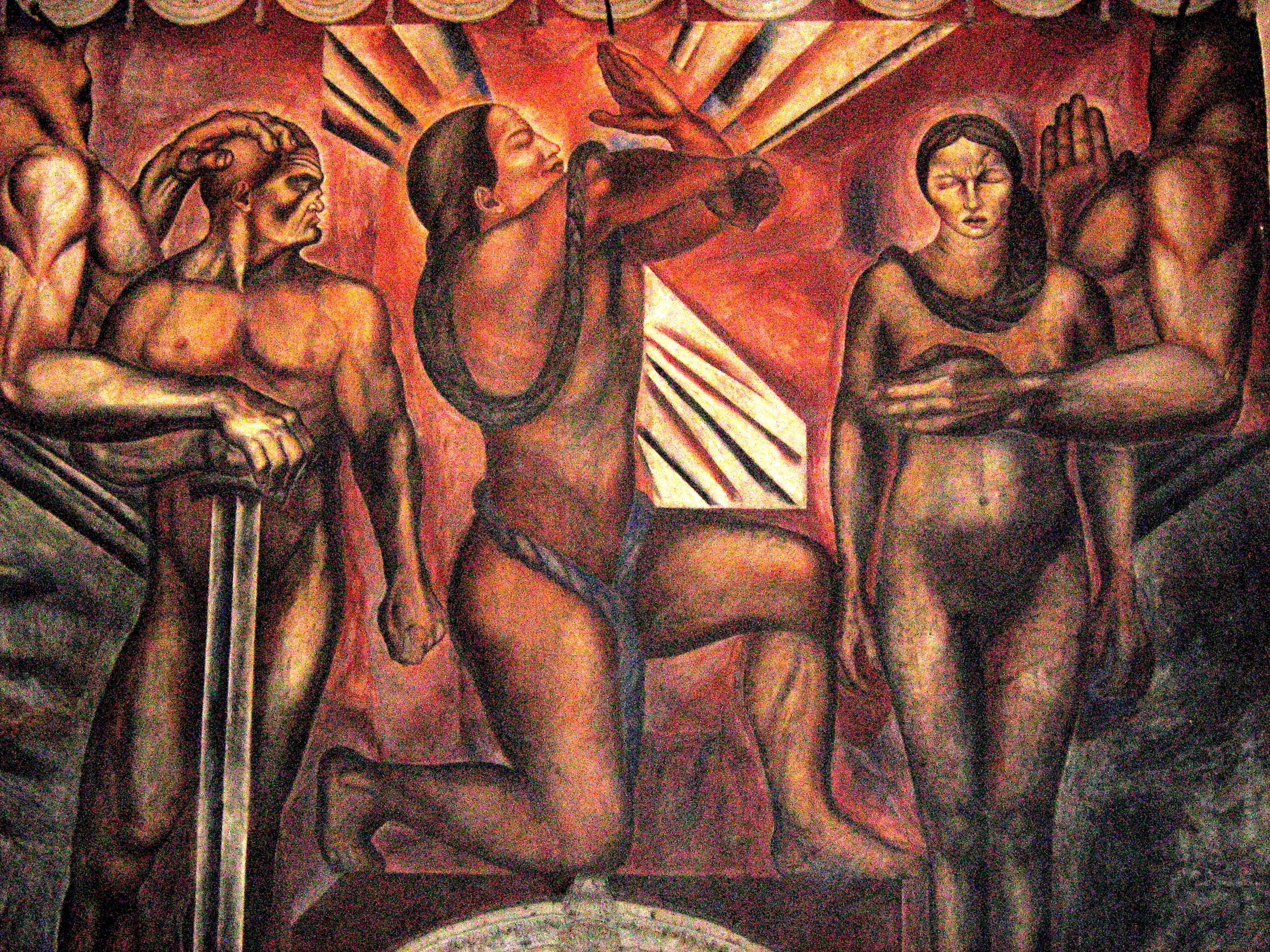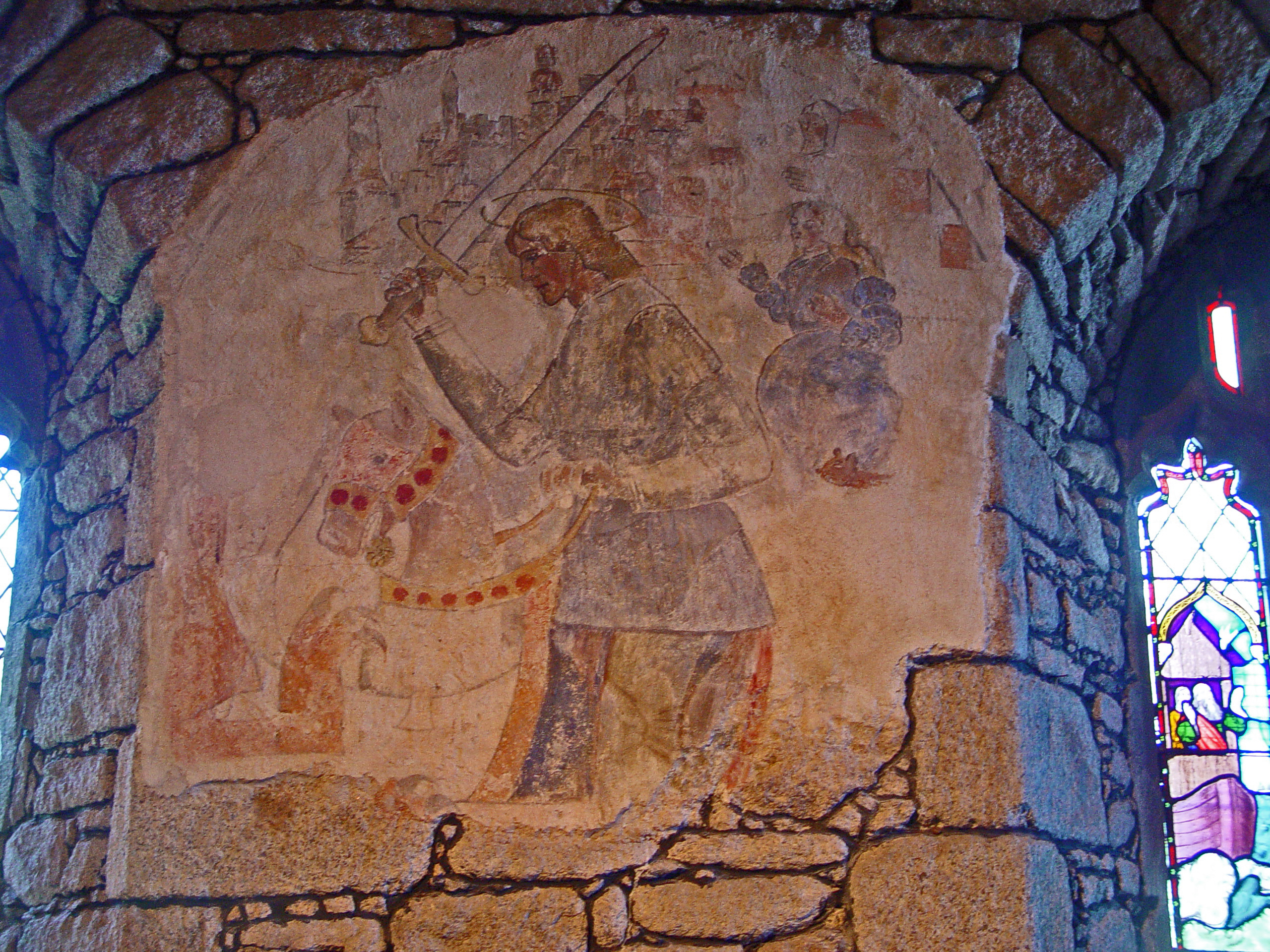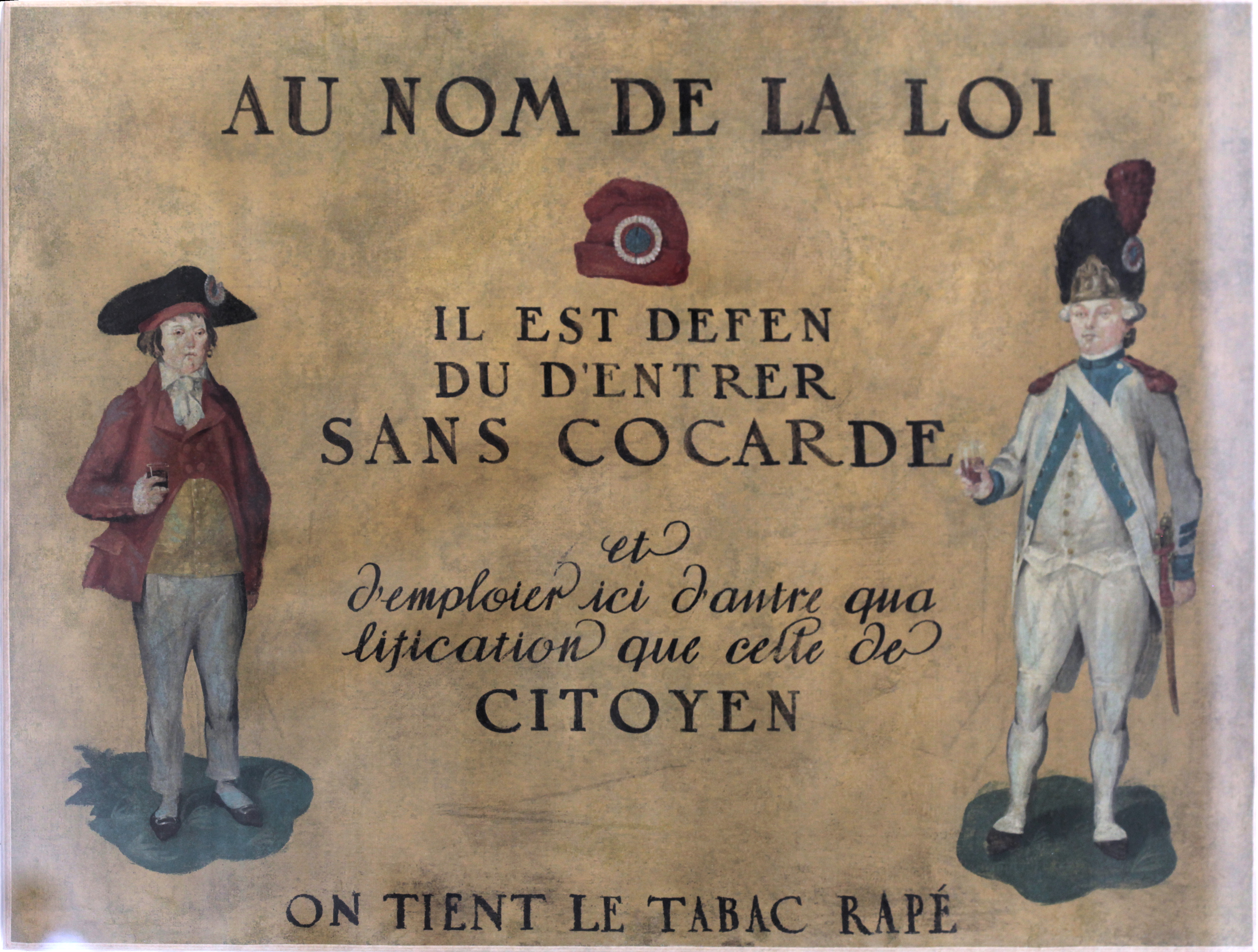|
Mural
A mural is any piece of graphic artwork that is painted or applied directly to a wall, ceiling or other permanent substrate. Mural techniques include fresco, mosaic, graffiti and marouflage. Word mural in art The word ''mural'' is a Spanish adjective that is used to refer to what is attached to a wall. The term ''mural'' later became a noun. In art, the word mural began to be used at the beginning of the 20th century. In 1906, Dr. Atl issued a manifesto calling for the development of a monumental public art movement in Mexico; he named it in Spanish ''pintura mural'' (English: ''wall painting''). In ancient Roman times, a mural crown was given to the fighter who was first to scale the wall of a besieged town. "Mural" comes from the Latin ''muralis'', meaning "wall painting". History Antique art Murals of sorts date to Upper Paleolithic times such as the cave paintings in the Lubang Jeriji Saléh cave in Borneo (40,000-52,000 BP), Chauvet Cave in Ardèche departmen ... [...More Info...] [...Related Items...] OR: [Wikipedia] [Google] [Baidu] |
David Alfaro Siqueiros
David Alfaro Siqueiros (born José de Jesús Alfaro Siqueiros; December 29, 1896 – January 6, 1974) was a Mexican social realist painter, best known for his large public murals using the latest in equipment, materials and technique. Along with Diego Rivera and José Clemente Orozco, he was one of the most famous of the " Mexican muralists". He was a member of the Mexican Communist Party, and a Stalinist and supporter of the Soviet Union who led an unsuccessful attempt to assassinate Leon Trotsky in May 1940. By accordance with Spanish naming customs, his surname would normally have been ''Alfaro''; however, like Picasso (Pablo Ruiz y Picasso) and Lorca (Federico García Lorca), Siqueiros used his mother's surname. It was long believed that he was born in Camargo in Chihuahua state, but in 2003 it was proven that he had actually been born in the city of Chihuahua, but grew up in Irapuato, Guanajuato, at least from the age of six. The discovery of his birth certificate in ... [...More Info...] [...Related Items...] OR: [Wikipedia] [Google] [Baidu] |
José Clemente Orozco
José Clemente Orozco (November 23, 1883 – September 7, 1949) was a Mexican caricaturist and painter, who specialized in political murals that established the Mexican Mural Renaissance together with murals by Diego Rivera, David Alfaro Siqueiros, and others. Orozco was the most complex of the Mexican muralists, fond of the theme of human suffering, but less realistic and more fascinated by machines than Rivera. Mostly influenced by Symbolism, he was also a genre painter and lithographer. Between 1922 and 1948, Orozco painted murals in Mexico City, Orizaba, Claremont, California, New York City, Hanover, New Hampshire, Guadalajara, Jalisco, and Jiquilpan, Michoacán. His drawings and paintings are exhibited by the Carrillo Gil Museum in Mexico City, and the Orozco Workshop-Museum in Guadalajara. Orozco was known for being a politically committed artist, and he promoted the political causes of peasants and workers. Life José Clemente Orozco was born in 1883 in Zapo ... [...More Info...] [...Related Items...] OR: [Wikipedia] [Google] [Baidu] |
Diego Rivera
Diego María de la Concepción Juan Nepomuceno Estanislao de la Rivera y Barrientos Acosta y Rodríguez, known as Diego Rivera (; December 8, 1886 – November 24, 1957), was a prominent Mexican painter. His large frescoes helped establish the mural movement in Mexican and international art. Between 1922 and 1953, Rivera painted murals in, among other places, Mexico City, Chapingo, and Cuernavaca, Mexico; and San Francisco, Detroit, and New York City, United States. In 1931, a retrospective exhibition of his works was held at the Museum of Modern Art in New York; this was before he completed his 27-mural series known as '' Detroit Industry Murals''. Rivera had four wives and numerous children, including at least one natural daughter. His first child and only son died at the age of two. His third wife was fellow Mexican artist Frida Kahlo, with whom he had a volatile relationship that continued until her death. His fourth and final wife was his agent. Due to his importance i ... [...More Info...] [...Related Items...] OR: [Wikipedia] [Google] [Baidu] |
Mural Crown
A mural crown ( la, corona muralis) is a crown or headpiece representing city walls, towers, or fortresses. In classical antiquity, it was an emblem of tutelary deities who watched over a city, and among the Romans a military decoration. Later the mural crown developed into a symbol of European heraldry, mostly for cities and towns, and in the 19th and 20th centuries was used in some republican heraldry. Usage in ancient times In Hellenistic culture, a mural crown identified tutelary deities such as the goddess Tyche (the embodiment of the fortunes of a city, familiar to Romans as Fortuna), and Hestia (the embodiment of the protection of a city, familiar to Romans as Vesta). The high cylindrical '' polos'' of Rhea/ Cybele too could be rendered as a mural crown in Hellenistic times, specifically designating the mother goddess as patron of a city. The mural crown became an ancient Roman military decoration. The ''corona muralis'' (Latin for "walled crown") was a golden c ... [...More Info...] [...Related Items...] OR: [Wikipedia] [Google] [Baidu] |
Roberto Montenegro
Roberto Montenegro Nervo (February 19, 1885 in Guadalajara – October 13, 1968 in Mexico City) was a painter, muralist and illustrator, who was one of the first to be involved in the Mexican muralism movement after the Mexican Revolution. His most important mural work was done at the former San Pedro and San Pablo monastery but as his work did not have the same drama as other muralists, such as Diego Rivera, he lost prominence in this endeavor. Most of his career is dedicated to illustration and publishing, portrait painting and the promotion of Mexican handcrafts and folk art. Life Roberto Montenegro Nervo was born on February 19, 1885 in Guadalajara.Balderas, p. 11 His parents were Colonel Ignacio L Montenegro and María Nervo, aunt of poet Amado Nervo. Montenegro had four sisters: Rosaura, Ana, Eva and María Eugenia and one brother, Arturo. The family was one of the beneficiaries of the Porfirio Díaz regime, leaving for the United States when the Mexican Revolution broke ... [...More Info...] [...Related Items...] OR: [Wikipedia] [Google] [Baidu] |
Kerala Mural Painting
Kerala mural paintings are the frescos depicting Hindu mythology in Kerala. Ancient temples and palaces in Kerala, India, display an abounding tradition of mural paintings mostly dating back between the 9th to 12th centuries CE when this form of art enjoyed royal patronage. The scriptural basis of these paintings can be found in the Sanskrit texts, 'Chithrasoothram'' - (Chitrasutra is a part of the Vishnu Dharmottara Purana, a book written in Sanskrit about 1500 years ago. It contains 287 short verses in nine chapters and a few prose in the second chapter. There is no other book on painting as detailed as the Chitrasutra. This book answers hundreds of questions about what a painting is, why, its purpose, role, relationship with the painter, connoisseurs, and other arts. Chitrasutra will be useful to understand the true Indian painting.)''Tantrasamuchaya,'' the fifteenth century text authored by Narayanan, '' Abhilashitartha Chintamani'' of the twelfth century and ''Silparatna ... [...More Info...] [...Related Items...] OR: [Wikipedia] [Google] [Baidu] |
Fresco
Fresco (plural ''frescos'' or ''frescoes'') is a technique of mural painting executed upon freshly laid ("wet") lime plaster. Water is used as the vehicle for the dry-powder pigment to merge with the plaster, and with the setting of the plaster, the painting becomes an integral part of the wall. The word ''fresco'' ( it, affresco) is derived from the Italian adjective ''fresco'' meaning "fresh", and may thus be contrasted with fresco-secco or secco mural painting techniques, which are applied to dried plaster, to supplement painting in fresco. The fresco technique has been employed since antiquity and is closely associated with Italian Renaissance painting. The word ''fresco'' is commonly and inaccurately used in English to refer to any wall painting regardless of the plaster technology or binding medium. This, in part, contributes to a misconception that the most geographically and temporally common wall painting technology was the painting into wet lime plaster. Even in app ... [...More Info...] [...Related Items...] OR: [Wikipedia] [Google] [Baidu] |
Graffiti
Graffiti (plural; singular ''graffiti'' or ''graffito'', the latter rarely used except in archeology) is art that is written, painted or drawn on a wall or other surface, usually without permission and within public view. Graffiti ranges from simple written words to elaborate wall paintings, and has existed since ancient times, with examples dating back to ancient Egypt, ancient Greece, and the Roman Empire. Graffiti is a controversial subject. In most countries, marking or painting property without permission is considered by property owners and civic authorities as defacement and vandalism, which is a punishable crime, citing the use of graffiti by street gangs to mark territory or to serve as an indicator of gang-related activities. Graffiti has become visualized as a growing urban "problem" for many cities in industrialized nations, spreading from the New York City subway system and Philadelphia in the early 1970s to the rest of the United States and Europe and other world ... [...More Info...] [...Related Items...] OR: [Wikipedia] [Google] [Baidu] |
Oxtotitlán
Oxtotitlán is a natural rock shelter and archaeological site in Chilapa de Álvarez, Mexican state of Guerrero that contains murals linked to the Olmec motifs and iconography. Along with the nearby Juxtlahuaca cave, the Oxtotitlán rock paintings represent the "earliest sophisticated painted art known in Mesoamerica", thus far. Unlike Juxtlahuaca, however, the Oxtotitlán paintings are not deep in a cave system but rather occupy two shallow grottos on a cliff face. The paintings have been variously dated to perhap900years BCE. It is not known what group or society painted them. It is also not known how Olmec-influenced art came to be painted hundreds of kilometers (or miles) from the Olmec heartland, although caves are prominent on many Olmec-style monuments, including La Venta Altars 4 and 5. Description The Paintings cover an area of about There is restoration work in 10 walls, it is expected to complete scientific investigation and establish the origin of the pai ... [...More Info...] [...Related Items...] OR: [Wikipedia] [Google] [Baidu] |
Fresco Secco
Fresco-secco (or a secco or fresco finto) is a wall painting technique where pigments mixed with an organic binder and/or lime are applied onto a dry plaster. The paints used can e.g. be casein paint, tempera, oil paint, silicate mineral paint. If the pigments are mixed with lime water or lime milk and applied to a dry plaster the technique is called lime secco painting. The secco technique contrasts with the fresco technique, where the painting is executed on a layer of wet plaster. Because the pigments do not become part of the wall, as in buon fresco, fresco-secco paintings are less durable. The colors may flake off the painting as time goes by, but this technique has the advantages of a longer working time and retouchability. In Italy, fresco technique was reintroduced around 1300 and led to an increase in the general quality of mural painting. This technological change coincided with the realistic turn in Western art and the changing liturgical use of murals. The treat ... [...More Info...] [...Related Items...] OR: [Wikipedia] [Google] [Baidu] |
Mosaic
A mosaic is a pattern or image made of small regular or irregular pieces of colored stone, glass or ceramic, held in place by plaster/mortar, and covering a surface. Mosaics are often used as floor and wall decoration, and were particularly popular in the Ancient Roman world. Mosaic today includes not just murals and pavements, but also artwork, hobby crafts, and industrial and construction forms. Mosaics have a long history, starting in Mesopotamia in the 3rd millennium BC. Pebble mosaics were made in Tiryns in Mycenean Greece; mosaics with patterns and pictures became widespread in classical times, both in Ancient Greece and Ancient Rome. Early Christian basilicas from the 4th century onwards were decorated with wall and ceiling mosaics. Mosaic art flourished in the Byzantine Empire from the 6th to the 15th centuries; that tradition was adopted by the Norman Kingdom of Sicily in the 12th century, by the eastern-influenced Republic of Venice, and among the Rus. Mosaic fell ... [...More Info...] [...Related Items...] OR: [Wikipedia] [Google] [Baidu] |
Marouflage
Marouflage is a technique for affixing a painted canvas (intended as a mural) to a wall, using an adhesive that hardens as it dries, such as plaster or cement. History A French word originally referring to sticky, partly hardened scraps of paint, marouflage is a 3,000-year-old technique. Historically, artists used several types of adhesives including a rabbit-skin glue. White lead ore was used in the 19th and 20th centuries in the mixture to help it dry. A thin coat of the adhesive is applied to both the wall and the canvas. Once the canvas is mounted to the wall, pressure is exerted with rubber hand rollers to smooth the canvas and remove any bubbles. Uses Conservation In art conservation, the word can be term of art Jargon is the specialized terminology associated with a particular field or area of activity. Jargon is normally employed in a particular communicative context and may not be well understood outside that context. The context is usually a particu ... meaning ... [...More Info...] [...Related Items...] OR: [Wikipedia] [Google] [Baidu] |







.jpg)


